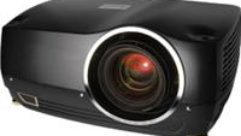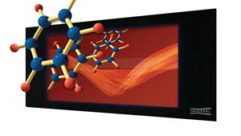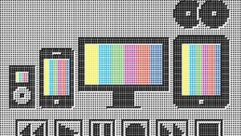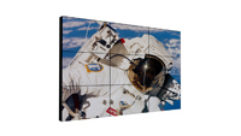
Here Come HD Optical Discs
THE DVD may be the most successful electronic gadget of all time. DVD players are everywhere, and they’re cheap, too. Every new computer sold today has at least one DVD-ROM drive in it.
THE DVD may be the most successful electronic gadget of all time. DVD players are everywhere, and they’re cheap, too. Every new computer sold today has at least one DVD-ROM drive in it.
DVD players evolved from SD interlaced playback through analog outputs to full-blown models with HD resolution video scaling through DVI and HDMI outputs. There are numerous write-once and write-many red-laser DVD formats, such as DVD-R, DVD-RW, DVD+R, DVD+RW, and even a new, dual-layer DVD format with 8.5 GB of capacity.
Now, manufacturers are setting two new blue-laser DVD formats upon us. Why? Because we now need to record and play back HDTV. Red-laser DVDs are fine for playing standard-definition video, but they don’t have enough capacity to hold a two-hour HD movie, encoded in MPEG-2 at 1920×1080 resolution (or 1280×720 resolution, for that matter).
And why do we need to play back movies or other video content in an HD format? Because our fixed-pixel displays (DLP, plasma, LCD, LCoS) have gotten so large with such high pixel density that SD video just isn’t good enough any more.
To complicate matters, there are two incompatible formats competing in the HD disc arena. The first is Toshiba’s HD-DVD, which uses a 405 nanometer (nm) blue laser and a 36 Mb/s constant data rate for playback with disc capacities of 15 GB (single layer) and 25 GB (dual layer). NEC, Sanyo, HP, and Microsoft have also endorsed it.
The second is Blu-ray, supported by Sony, Panasonic, Pioneer, Sharp, Philips, Samsung, LG, HP, Apple, and Dell. Blu-ray also uses a 405 nm blue laser and a 36 Mb/s constant data rate. However, it has a larger numerical aperture and thus greater storage capacity, with 25 GB standard on single-layer discs and 50 GB available on dual-layer discs.
At first glance, a blue laser DVD doesn’t look much different than a red-laser DVD. In the case of HD-DVD, the similarities run deeper — both RL-DVD and HD-DVD have a 0.6 mm protection layer and almost the same numerical aperture (0.6 mm for RL, 0.65 mm for HD-DVD). The lasers also sit the same height from the disc surface at 1 mm.
Blu-ray, while it offers greater capacity over HD-DVD, has a shallower protection layer (only 0.1 mm) and a much wider aperture (0.85 mm). In addition, the blue laser pickup sits almost on top of the DVD surface with a spacing of about 0.3 mm. So it’s a whole different ball of wax for mastering and burning.
If you guessed that neither disc format works in the other guy’s players, you win the prize! So, how can a consumer possibly know which format to go with? Which will be the winner?
Both systems support a wide range of digital codecs, including MPEG-2, MPEG-4 (AVC), and even Windows Media. No advantage there. Both will encode movies in a 1080p/24 format for the North American market, with the capability in the future to show 24p native, or double or triple to 48 Hz and 72 Hz, not to mention perform 2:3 pull-up to 60 Hz. Again, no advantage to either side.
Here Come HD Optical Discs
THE DVD may be the most successful electronic gadget of all time. DVD players are everywhere, and they’re cheap, too. Every new computer sold today has at least one DVD-ROM drive in it.
The competition could be decided simply by who gets there first. As of late June, Toshiba already had its player (HD-A1, $499) to market, and at least 13 HD-DVD movies were available from Warner Home Video and Universal.
Blu-ray also made its appearance in late June with Samsung’s BD-P1000 ($999), to be followed later this year by Sony, Panasonic, Philips, LG, and Pioneer. (Lurking in the shadows is Sony’s PlayStation 3, a Blu-ray compatible design scheduled for a November 2006 launch.)
Too expensive, you say? Well, Sony’s offering is about $999, while Panasonic and Pioneer will come in at $1,300. Only the yet-to-be-seen PS3 box offers a competitive price for Blu-ray, tentatively in the $500 to $600 range.
And there’s the crux of the problem. We’ve been conditioned over the past 10 years to understand that DVD players are cheap (and they really are), and that DVD media is also cheap and ubiquitous (and it is). Of course, when the first DVD players appeared on store shelves back in 1997, they also cost much more than $1,000.
But their winning combination of speed, image quality, durability, digital surround audio, random access, menu navigation, and support for widescreen modes ensured that market demand would follow, driving prices down. That’s not a sure thing for either HD-DVD or Blu-ray, and they’ve complicated things with a format war.
To be fair, both camps have also announced plans for PC drives to burn and read blue-laser DVDs. Numerous companies have already announced pricing for and availability of blank 25 and 50 GB Blu-ray disc media, and Pioneer is now showing a Blu-ray burner. While the HD-DVD folks haven’t specifically announced any burners or drives, at least three companies will offer the blank media in 15 and 30 GB capacities.
Several movie studios have lined up behind each format, with Warner Bros, New Line, Paramount, and Universal in the HD-DVD camp, and Sony Pictures, Warner Bros, Fox, MGM, Paramount, and Disney backing up Blu-ray. (Sony’s choice is obvious, but also note how Warner and Paramount have their feet firmly planted in both camps. Future-proofing, perhaps?)
What’s standing in the way of success? How about non-proprietary storage media such as flash drives? Using MPEG-2 encoding, you’d need about 9 GB per hour of recording capacity, and Samsung recently announced the development of 16 GB flash memory. Given that 1 GB flash drives are now selling for less than $50, it won’t be too long before we’ll have enough storage capacity for a two-hour movie on a pen drive, which could be moved to any number of playback devices.
Portable hard disc drives are also plummeting in price. Verbatim now has an 8 GB Stor’N’Go drive for less than $200. How long before those become 16, 32, or 64 GB drives? What’s more, you can already record an hour of HD with constant bit rate to an 8.5 GB red-laser DVD. With additional efficiencies from MPEG-4 or WM, that could be enough to store almost two hours with a little tweaking.
Here’s another thought: With expanded HD video-on-demand from cable and Telco (IPTV) service providers, do you really need to buy or rent high-definition DVDs? Perhaps the real appeal of recordable HD discs would be that you could buy a VoD HD movie you just viewed and burn it to a blue-laser disc in your set-top box.
Here Come HD Optical Discs
THE DVD may be the most successful electronic gadget of all time. DVD players are everywhere, and they’re cheap, too. Every new computer sold today has at least one DVD-ROM drive in it.
Certainly the high-end home theater aficionados who are chomping at the bit to find content for their new 1080p HDTVs will snap up players and movies, providing some initial momentum. But the rest of the market has a hard enough time telling when they’re watching HDTV and when they aren’t on their new plasma, LCD, and rear-projection TVs.
In fact, if the HDTV has a screen size smaller than 50 inches, it’s a safe bet that most viewers won’t see the difference between a blue-laser DVD and a red-laser DVD processed with a top-notch HD video scaler and played in progressive scan mode.
Funny — I remember when JVC’s D-VHS (D-Theater) came out a few years ago it was supposed to be the hottest thing since DVDs, offering a 25 Mb/s data rate, true 1920×1080 HD playback, and digital surround audio. But you don’t see too many of those players these days, and all of the Hollywood studios that supported the format have quietly withdrawn their titles from the market.
Will HD-DVD and Blu-ray succeed — or become the next D-VHS? Only time will tell.
Pete Putman is a contributing editor for Pro AV and president of ROAM Consulting, Doylestown, PA. Especially well known for the product testing/development services he provides manufacturers of projectors, monitors, integrated TVs, and display interfaces, he has also authored hundreds of technical articles, reviews, and columns for industry trade and consumer magazines over the last two decades. You can reach him at [email protected].










